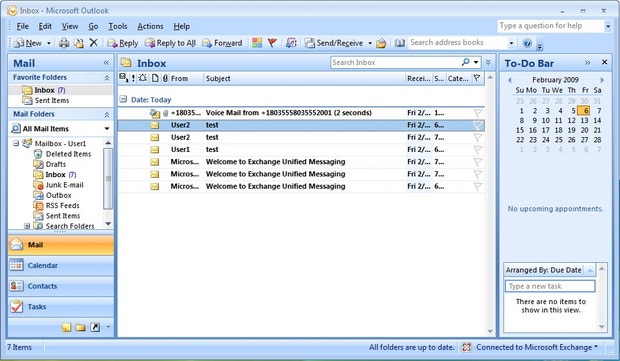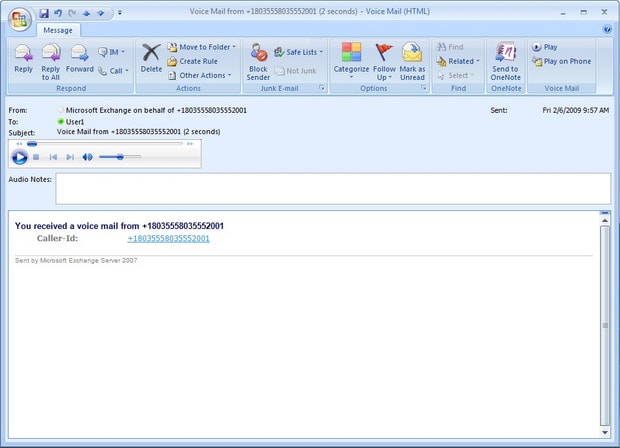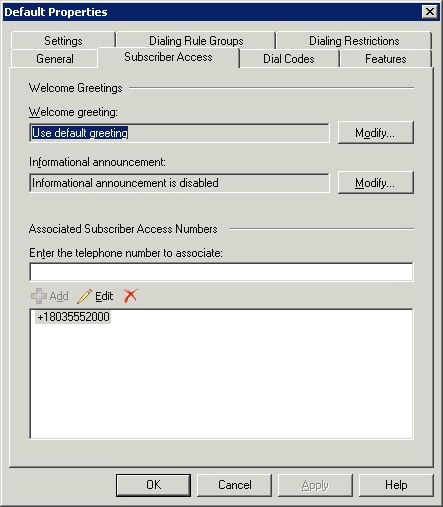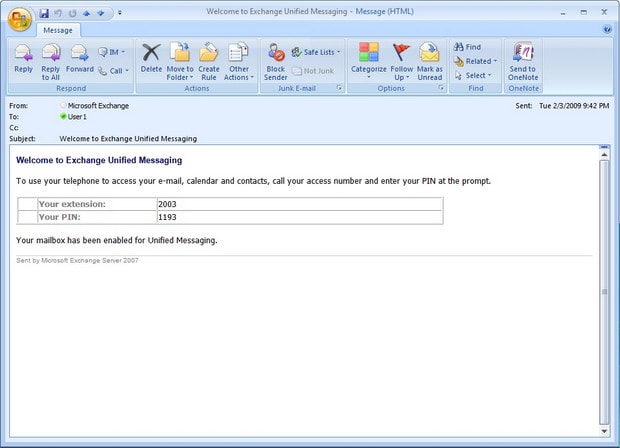One of the least understood Exchange 2007 features has got to be Unified Messaging. Unified Messaging isn’t really all that difficult to install, but it does require some specialized hardware and a degree of telephony knowledge, and that seems to scare some administrators away. I’ll start out by talking about what Unified Messaging is, and about some of its features. I will also talk about some common misconceptions associated with Unified Messaging. Later on I will talk about the benefits that Unified Messaging can bring to the enterprise, and about where I think that Unified Messaging is headed in the future.
What is Unified Messaging?
Unified Messaging is an Exchange Server role that was introduced in Exchange Server 2007. The basic philosophy behind Unified Messaging is that users communicate in a variety of different ways. Some users prefer to send E-mail messages, while others prefer using the telephone. In fact, I tend to think that this is a big part of the reason why smart phones are so popular. They allow people to receive E-mail messages and telephone calls on the same device.
In a corporate environment though, a user typically has two separate mailboxes; one for E-mail messages, and another one for voice mail messages. Furthermore, voice mail has traditionally been tied to the telephone. Although it is common for voice mail to be remotely accessible, users often find themselves scribbling down names, numbers, or messages on pieces of paper, which often get lost.
Microsoft designed Exchange 2007 so that the Inbox allows users to store E-mail messages, voice mail messages, and faxes all in the same place. This frees the user from having to look for messages in multiple locations. It also gives users a way to make voice messages searchable, as I will show you later on.
If you look at Figure A, you can see an example of what a user’s Inbox looks like after Unified Messaging has been enabled. Notice in the figure that the message at the top of the list contains a telephone icon, which reflects the fact that it is a voice mail message. In this case, the From field displays the phone number that the call was from, and the subject line also tells us that this is a voice message, and who it is from.

Voice messages are stored in the user’s Inbox.
If you look at Figure B, you can see what it looks like when I open this voice message. As you can see in the figure, Outlook displays an audio plug-in just beneath the message’s Subject line. This allows you to play the message directly through Outlook.

This is what a voice message looks like.
Remember earlier when I said that users often take notes about voice messages on paper, and a lot of times those notes end up getting lost? Well, if you look just beneath the audio plug-in, there is an Audio Notes field. Users can take notes about the message in this field. These notes are saved when the user closes the message. That way, when a user performs a search on their Inbox, Outlook searches both E-mail messages, and the notes that have been attached to voice mail messages.
Notice in the figure that this message contains a Reply button, just like an E-mail message does. If you click the Reply button, you can respond to the voice message with an E-mail message. Of course this only works if the message was left by a user who has Unified Messaging enabled, because Outlook must look up the phone number in the Active Directory, and figure out which user the number belongs to so that it can send a message to them.
Another thing that I want to point out is the Call icon, located within the Respond section in Figure B. Clicking this icon allows you to return the call rather than requiring you to respond to the voice message through E-mail.
One last thing that I want to show you about this message is the Play on Phone icon. Normally, when you play a voice message, the voice message is played directly through Outlook, on your computer’s speakers. The problem with this is that in a crowded office, privacy can sometimes be a concern. If you don’t have a set of headphones to plug into your computer, you can use the Play on Phone icon to redirect the message to a telephone. That way, you can listen to the message without the entire office over hearing it.
When you click this icon, Outlook asks you to enter the phone number of the phone that you want to play the message on. Outlook then dials the number, and allows the user to listen to the message on the telephone.
Although Unified Messaging is great for storing voice messages and faxes alongside E-mail messages, this in only one of the two major Unified Messaging features. The other major feature is Outlook Voice Access (OVA). Just as Outlook Web Access (OWA) allows users to access their mailboxes through a Web browser, OVA allows users to access their mailboxes over the telephone.
When you initially configure Unified messaging, you’re given the opportunity to associate a phone number with a dial plan, as shown in Figure C. This phone number is known as a Subscriber Access Number. It is the number that users can call to access Outlook Voice Access.

A subscriber Access Number provides access to OVA.
After Unified Messaging is set up, you must enable the various mailboxes for unified messaging. When you do, you are required to either provide a PIN for the mailbox, or to tell Exchange Server to automatically generate a PIN. This PIN is used when the user logs in to OVA.
After a mailbox has been enabled for Unified Messaging, Exchange Server sends a Welcome to Exchange Unified Messaging message to the mailbox. This message confirms the user’s extension number (which they should already know), and provides them with their PIN. Once the user has this information, they can use Outlook Voice Access to interact with their mailbox over the telephone. You can see an example of the Welcome to Exchange Unified Messaging message in Figure D.

Users are automatically sent a message containing their extension number and PIN.
If a user wants to use OVA, they simply call the subscriber Access number. When they do, Exchange Server will prompt them to enter their extension followed by their PIN. The user enters this information by using the touch tones on their telephone. This authentication method is used in place of the traditional username and password.
Once the user has logged in to OVA, they are free to listen to their e-mail messages or to verbally compose new e-mail messages. They also have the ability to interact with their calendar. Users can schedule or reschedule meetings, mark a timeslot as busy, or do just about anything else that they could do to their calendar through Outlook.
The nice thing about OVA is that users can interact with it verbally, or they can use the touchtone keypad on their phone. It has been my experience that the voice recognition software that OVA uses is quite good. In fact, I have even been able to use OVA to verbally check my e-mail in my car while I am driving.
Misconceptions about Unified Messaging
Probably the biggest misconception about Unified Messaging is that it is a full-blown unified communications solution. In actuality though, nothing could be further from the truth. It important to remember that Unified Messaging is only one part of Microsoft’s unified communications strategy. Microsoft offers a completely separate product called Office Communications Server 2007 (OCS) that is designed to be a full-featured unified communications product.
OCS 2007 is the successor to Microsoft’s Live Communications Server product line. It allows users to place and receive voice and video phone calls using Microsoft Office Communicator. Furthermore, OCS 2007 can be configured as a mediation server, which can act as a bridge to the organization’s IP enabled PBX system. This allows external phone calls to be routed to the desktop. Of course users also have the ability to place external calls as well.
The one thing that OCS 2007 really seems to be missing is a voicemail feature. As you might have already figured out though, OCS 2007 and Exchange Server 2007 can be configured to work together so that voicemail capabilities and OVA can be integrated into the organization’s unified communications solution.
One thing to keep in mind though is that the process of making OCS 2007 and Exchange Server 2007 work together is not completely seamless. Exchange 2007 was completed before OCS 2007. Therefore, Microsoft does not offer full OCS 2007 support in Exchange 2007 unless you install SP1. Even then, the setup process requires you to run an obscure script that tells Exchange Server 2007 to treat the OCS Enterprise Pool as a VoIP gateway. The script also sets the necessary permissions for the two products to work together.
The Benefits of Unified Messaging
Unified Messaging is the most resource intensive of all of the Exchange 2007 server roles, and using it requires additional hardware that bridges the gap between the corporate network and the PBX system. Often times, the resource intensive nature of the Unified Messaging role means that companies that want to use Unified Messaging will end up having to deploy multiple Unified Messaging servers. Even if it does not initially seem that Unified Messaging is going to be all that resource intensive, it is important to remember that voice mail is “real time” in nature. Something as simple as a dropped packet can introduce jitter and cause part of a message to be lost.
Organizations may also find themselves having to beef up their mailbox servers because of the additional load to voice messages place on the storage subsystem. Obviously, implementing Unified Messaging is going to be an expensive endeavor in most cases because of all of the additional hardware requirements. It is therefore essential to consider how Unified Messaging is going to be a benefit to the organization.
In my opinion, the biggest benefit that Unified Messaging provides is Outlook Voice Access. In this day and age, users often need access to their mailboxes at a moment’s notice. Occasionally, users may find themselves in a situation in which they do not have access to an e-mail client, or in which using a traditional e-mail client is impractical. Telephones however, are universal. This makes it possible for users to check, and respond to messages from almost anywhere in the world.
I also think that having voice messages and e-mail messages stored in the same mailbox provides a great benefit to the organization. Using consolidated storage may not initially seem like a big deal. However, it may allow remote users to work more efficiently. It also allows them to instantly be alerted to new voice messages. Traditionally, users would have to dial into a voicemail system in order to find out if they have any new messages waiting or not, although some systems support paging, message forwarding, and other alerting features.
I also like the idea that a consolidated mailbox allows users to have one place to manage all of their communications with clients. Since voice notes are searchable, it becomes easy for a user to enter a client’s name into the Outlook Search box and see every conversation that they have ever had with the client, regardless of whether it was over voicemail or e-mail.
One last benefit that I want to talk about is faxing. Fax machines are quickly becoming obsolete, but they do still have their place. This is especially true in situations in which a signature is required on a document. Unified Messaging not only give each user fax capabilities, but it allows faxes to be routed directly to the recipient rather than ending up in a communal fax server in which privacy may be an issue.
The Future of Unified Messaging
In the future, I expect to see a much closer relationship between Exchange Server and Office Communications Server (OCS). This is evidenced in the way that Microsoft has begun aligning the version numbers of these products.
A few years ago, Microsoft decided to renumber their internal Exchange Server release numbers to match the version numbers that were being used by the Microsoft Office team. Both the Exchange team and the Office team used 12 as the version number for their products that were released in 2007. What is interesting is that although Exchange 2007 and OCS don’t work together quite as seamlessly as Exchange and Office do, the OCS team also adopted 12 as their most recent version number.
The OCS team has recently released a new version of OCS which is called Microsoft Office Communications Server 2007 R2. The OCS team used 13 as the version number for this product, so the Exchange team and the Microsoft Office team chose 14 as the version number for their next release. This shows that the Exchange team is committed to making Exchange and OCS a “better together” experience.
At the present time, Microsoft hasn’t publicly released any information regarding how Unified Messaging will evolve in the next Exchange Server release, and in future releases beyond Exchange 14. Even so, there are some clues as to what might become of Unified Messaging, and Microsoft’s Unified Communications infrastructure as a whole.
Microsoft has firmly committed itself to its Software + Services initiative. The basic idea behind this initiative is that Microsoft plans to use the power of locally installed software in conjunction with distributed Web services to create a much more collaborative computing experience in which data and information services are available anywhere, regardless of a user’s location and the type of device that they are using.
Although Microsoft’s complete Software + Service vision is still several years away from being fulfilled, Exchange 14 is slated to be the first version of Exchange that can be operated as either software or as a service. Exchange 14 is designed to be installed on local servers, but Microsoft has also made it clear that they intend to offer hosted Exchange services that are powered by Exchange 14 as well.
Microsoft’s Software + Services initiative has already started showing up in some of the company’s other product lines as well. If you want to see what the future of Unified Messaging and Unified Communications may be like, then I think that the product that is the most worth paying attention to right now is Xbox 360.
The reason why I say this is that Xbox 360 fits into Microsoft’s Software + Service initiative in that it can act as a standalone unit for playing games and movies, but it also offers collaborative services through a service known as Xbox Live.
Xbox Live offers a glimpse into the future of Unified Communications in that it allows gamers to talk to each other through a VOIP connection while they are playing games, or outside of a game. A feature called Xbox Live Vision also offers video conferencing capabilities.
OCS offers VOIP calling capabilities today through a feature called Enterprise Voice, and it also offers video conferencing capabilities. Although these features are designed to be easy to use, they tend to be difficult for an administrator to initially setup. In fact, before an administrator can deliver all of the capabilities offered by Unified Messaging and Unified communications, they need to have expertise in Exchange Server, OCS, traditional networking, telephony, and Windows. The deployment is so complicated in fact, that I am in the process of writing an entire book on the subject. In contrast, Xbox Live users can access these same basic capabilities today, but with almost none of the headaches that are associated with the initial setup process.
I look for Microsoft to turn Unified Messaging and Unified Communications into extensible services in the Exchange 15 time frame. My guess is that by doing so, they will make unified communications and unified messaging much easier to implement.
At the same time though, I don’t expect these products to totally become hosted services. If Microsoft redesigned all of their server products so that they were only available as hosted services, or so that using the products as hosted services was the most attractive licensing model, there would almost certainly be a tremendous backlash from the IT community.
Imagine for instance what would happen if Exchange were only available as a hosted service. Administering Exchange would largely be confines to tasks such as setting up mailboxes or resetting passwords. If that happened, most of today’s Exchange administrators would be out of work. The reason why I say that there would be a backlash is because most administrators aren’t going to recommend that a company implement a solution that they know is going to put them out of a job. Instead, they would probably look for a competing product that offered the promise of job security. I think that Microsoft probably realizes this and although they are committed to delivering on their software + services initiative, they will still make future versions of Exchange and OCS flexible enough to meet varying demands of their customers and complicated enough to appease Exchange admins.
Conclusion
Unfortunately, I don’t have a crystal ball so I can’t tell you what the future holds for Unified Messaging or for unified communications in general. Even so, I can tell you that both Unified Messaging and OCS seem to be gaining popularity, so it is highly unlikely that they are going to go away in the future.
Organizations have been using PBX systems for many years as a way of giving them the freedom to configure their internal phone systems without having to involve the telephone company each time that they want to make a change. I think that as future versions of these products are released, we will eventually start seeing unified communications products such as Exchange and OCS start to replace traditional PBX systems in the enterprise.



Load comments